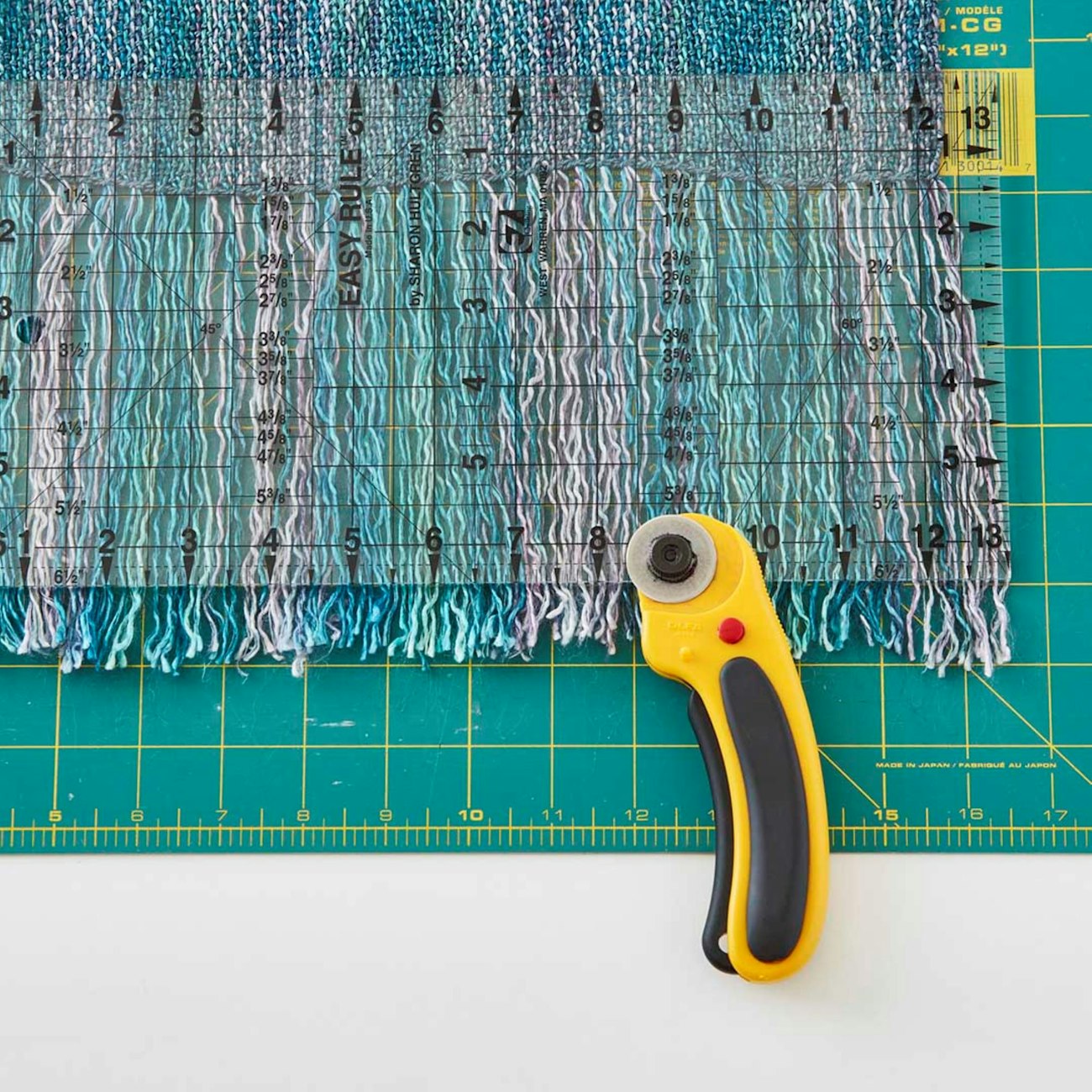Finishing handwoven projects is not high on the list for many weavers—we enjoy weaving, but may stumble when it comes to trimming, hemming, and fringing our projects. Fringes end up unevenly twisted or carelessly trimmed, weft tails may poke out of the fabric willy-nilly, and machine stitching may be hastily done in a color that distracts from the beauty of the project.
To me, rushed finishing is like eating a delicious dinner over the kitchen sink. The way I see it, after you‘ve spent all that time designing and weaving a project, taking another hour or two on careful finishing is time well spent. Here are some tips for finishing well.
Plan Your Finish Before You Weave
Finishing your projects with confidence starts with good planning from the start. You may even want to try out various finishing options as you sample yarns or setts. There‘s nothing like seeing what a particular finish looks like on a sample swatch to help you make up your mind.
- Whether you plan to hem or fringe your project, calculate your warp length carefully. Once your warp is on the loom, you can’t make it longer!
- If your piece will be hemmed, plan your draft so that the hems don’t interfere with the overall design. They should serve as a border for your piece, rather than cutting off a chunk of the last motif.
- As you‘re weaving, you can reduce hem bulk and make hem folds cleaner by using a thinner thread (such as sewing thread or 20/2 cotton) for the inner portion.
- If you have a few shafts to spare, consider weaving a doubleweave or tubular hem—which helps you avoid ruffled hems, makes a hemmed fabric reversible, and reduces hem bulk. Elisabeth Hill lays out how to do it in the November/December 2023 issue of Handwoven.
- If you plan to hem, lashing onto the front apron rod is a better choice than tying on, as it creates less loom waste.
- If you want long fringe, you can use loom waste for fringe, so tying on is the better choice. If you‘re worried that your tie-on isn‘t long enough, go ahead and tie on, spread your warp, untie one of your bouts, and measure it. Twisted fringe can have a lot of take-up, so add an extra 30% to the length of fringe you want (for example, for 6” fringe, allow 8” of unwoven warp). Give yourself some leeway in case not all of your ends are exactly the same length, but don’t be overly generous—you don’t want to run out of warp because of carelessly tying on.
- If you plan to use both hemstitching and fringe, your decision to lash on or tie on should be based on your desired fringe length. For fringe that is less than 3” long, lashing on will probably work—check that you have enough length between the knots and the start of the scarf, plus an inch or so. If you want fringe that is longer than 3”, tying on is a better choice, although you‘ll have to undo the knots when removing the scarf from the loom.
And don‘t forget to write down what you did in your weaving notes, so you remember it for next time.
Twisting Fringe? Be Methodical
For the best fringe results, keep these points in mind—and take your time as you work.
- If you want to combine hemstitching and twisted fringe, it's important to plan ahead—both for the number of warp ends you‘ll wrap with each hemstich, and for the number of fringes you‘ll twist. Your goal is to end up with the right number of hemstitched bundles to twist in consistent groups. Sprinkle any “odd” ends among your hemstitched bundles if you need to.
- If your warp is a mixture of yarns, wet finish your project before twisting so that uneven shrinkage doesn’t distort the fringe. And secure your warp ends with knots or with woven scrap yarn headers and zigzag stitching so they won’t get tangled in the wash.
- If your fringe looks skimpy (or you‘d like to add some colors from the weft), bulk it out by adding a few more lengths of yarn to knots sitting against the end of the fabric, or stitch them into the last few picks.
- For consistent fringes, twist each group the same number of times. If you‘re interrupted while twisting fringe, write this number down so you don‘t forget it.
- To finish a twisted fringe, tie an overhand knot about 1" from the end, to allow leeway for making adjustments.
- After twisting and knotting fringe, lay the project on a flat surface and adjust knot positions as needed to align them. Give the fringes one final trim so they‘re all the same length.
Here‘s a comprehensive look at how to twist fringe with pictures, if you‘d like to learn more.

You can trim fringe before or after twisting it with scissors, but a rotary cutter used with a straight edge does a better job of getting it even. Photo by George Boe
Hemming? Tips and Tools
Whether you plan to handstitch or machine stitch your hems, here are some tips to help.
- If you‘re weaving plain weave hems, use doubled picks as fold lines: Weave the inside-hem allowance and then repeat the last pick before starting the under-hem; when the under-hem is done, repeat the last pick again.
- After trimming the scrap yarn off your piece, fold and press the inside-hem, then fold the under-hem and press again. Open up the hem and apply fusible or adhesive hem tape to the under-hem. Fold the hem back together and press. Handstitch or machine stitch with matching thread.
- When machine hemming, you can avoid creating “ears” on the hem‘s ends by using a walking foot, which will move both layers under the needle at the same rate.
- When machine hemming, place a small piece of cardboard under the presser foot at the start and end of the hem to raise the presser foot level with the handwoven fabric. This step prevents the machine from getting stuck and creating a blob of threads under the fabric.
- After hemming, whipstitch the short gaps along the selvedges together for a neater finish.

Bonnie Innouye planned for doubleweave hems on her beautiful silk scarves in Loom Theory 2018. They turn inward so that the scarves, although hemmed, are truly reversible. Photo by Caleb Young, Good Folk Photography
Just as a beautifully set table makes a delicious dinner even more special, thoughtful finishing techniques make a lovely handwoven item that much more beautiful.
Weave well,
Susan
Originally published June 10, 2019; updated March 5, 2025.

